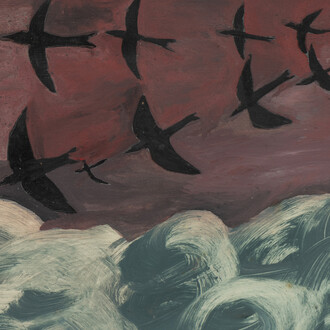In these variegated bodies of work, perceptions of the world we inhabit are defied and mutated into unique portrayals which journey us across time and space. At times surreal and abstract, the disparate interpretations of nature, society, and daily musings in Divergent Realities transport the viewer into fantastic realms at once both recognizable and enigmatic.
Asta Caplan hovers with ease in the middle ground between drawing, painting and photography. Interested in the most delicate, intimate and immaterial of subjects, her work is ultimately about perception, the pleasure we take in looking and the profundity of visible beauty.
Not to be mistaken for computer-programmed polygons, Seth Benzel’s square canvases reveal a visceral strain on the part of his subjects. Benzel’s paintings are intricate and bright constructions that both evoke a sense of colossal mythology and modern counter-culture.
Born Peter Castro in New York City, American painter Castro ART is one of the most energetic voices in contemporary art. Castro combines traditional media - acrylic and oil paint - with modern techniques reminiscent of street art and graphic illustration.
British glass artist Dominic Fondé uses the process of drill engraving to explore the many narratives spun by both memory and emotional attachment surrounding the experiences of love, loss, trust, and forgiveness.
Warren S. Heaton communicates the spontaneous nature of his native environment by painting on site, recreating each landscape as he experiences it, even in less than ideal weather conditions. “I enjoy the journey of each painting,” he says.
Susan Marx is an Abstract Impressionist whose paintings are the result of her radical amazement at the beauty of the visual world and her need to turn that experience into paint. Marx paints her interpretation of what nature leaves her with.
Artist Brenda Ness-Cooper’s eye for detail provides viewers a glimpse into the uniqueness of each location: the small particulars of local flowers or inclusion of footprints in the sand make each scene seem like a private retreat.
Maurice van Tilburg’s paintings represent the journey towards deeper expression by combining the concepts of beauty and pity. In that borderland between beauty and pity, the viewer glimpses the artist as an intense creator/achiever and also as a reflective man, and the struggles they both face in order to take what van Tilburg calls “full ownership of life.”
In her Perpetual Order series, Margaret Vega juxtaposes the landscape with the figure, using surface writing, gold leaf and wax elements to represent concepts of impermanence, fragility, and the human desire to be remembered.
Max Werner’s rendering of the light gives his images a mystical quality that borders on surrealism as it transforms ordinary landscapes and figures into terrains deep with symbolism and meaning.
Japanese artist Mituyasu Yokota developed his own medium and process as a contemporary means of respecting and reviving the traditional art of Japanese Kimono and Obi. In his works, Yokota fuses traditional Japanese papers to glass, occasionally incorporating extra three-dimensional elements like diamonds and, in some works, actual vintage Kimonos from the Edo period.
















